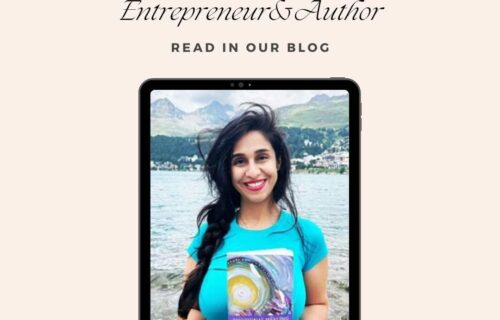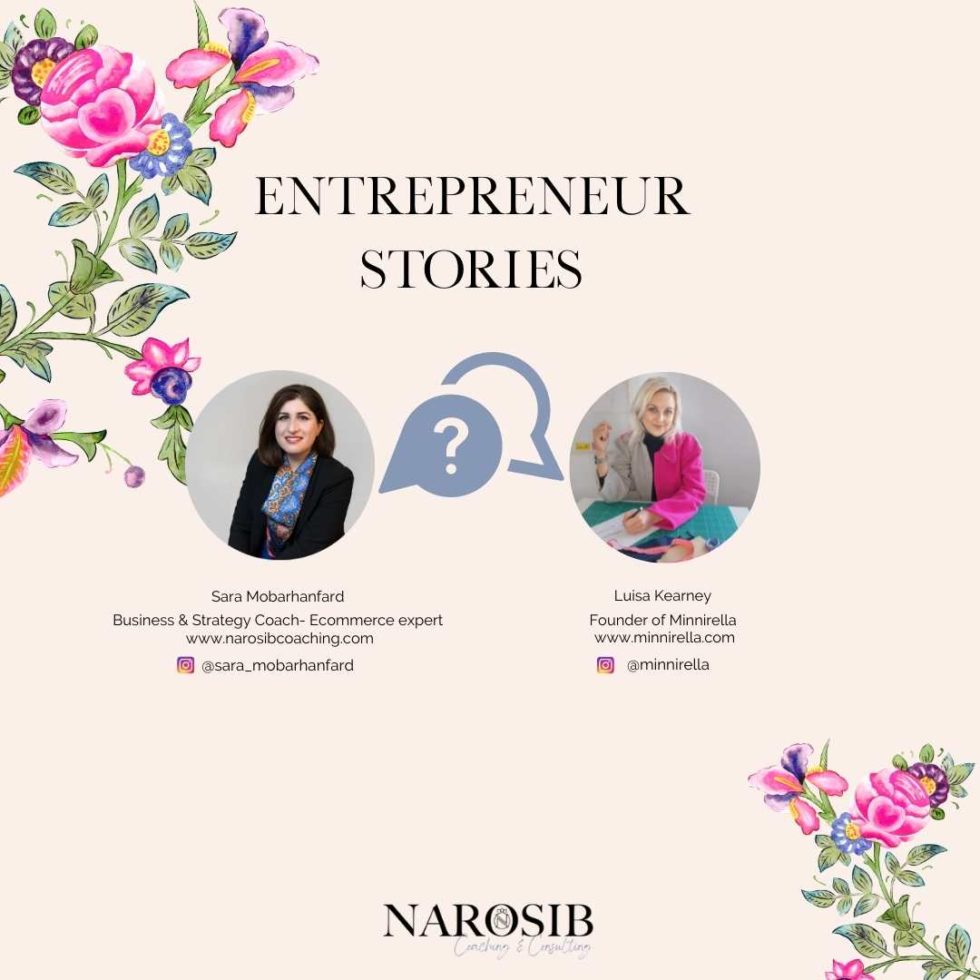
How to grow a zero-waste luxury fashion brand?
Entrepreneur stories, episode 1
In the first episode of entrepreneur stories I had the joy of talking to Luisa Kearney an inspirational woman entrepreneur,the founder of a zero-waste fashion brand and a lifestyle magazine.
Luisa is one example of a multi-passionate creative who has been able to bring all her seemingly different and irrelevant skills and passions into one business. Watch this talk (or read the transcribed interview) and see how Luisa combines running a magazine editorial team with growing a zero-waste fashion brand.
Watch the full interview here :
Interview transcript
Sara Mobarhanfard:
My guest today is Luisa Kearney, a woman entrepreneur and the founder of Minnirella,a luxury Zero-Waste fashion brand.
Hi Louisa. Tell us about yourself and what you do!
Luisa Kearney:
I’m Luisa and I am the founder of Minnirella, which is a zero waste luxury fashion brand for women. We also have a quarterly magazine as well. As you’re shopping, we cover the whole experience for our customers. Whilst you’re browsing on our website, you can read some of our styling tips, you can read just lifestyle content. And also you can read tips on how to maintain your clothes and look after them!
Sara Mobarhanfard:
That’s so exciting. I shall get back to the magazine topic later! I find it very interesting that you have your own brand with the product side of it and you have this magazine.
What made you start your business? And what did you do before that?
Luisa Kearney:
I’ve actually done quite a few different things! I had quite a few different businesses before this.
My first business was an online travel and lifestyle magazine.
Then a couple of years after that I ran a translation, language transcription and linguistics company. That was like copywriting to translate translation services, transcription services and things like that.
And that was quite interesting!
Again, it was sort of connected to words and text, which is related to what I do now and before with the magazine and blogs.
In 2014 I left the translation company to start Minnirella.
Originally, it was like a blog that I just ran on my own. I was a trained fashion stylist.I wanted to share my experiences, my styling tips, my online styling services, and also have a blog where people could learn about what to wear.
The blog gradually grew.
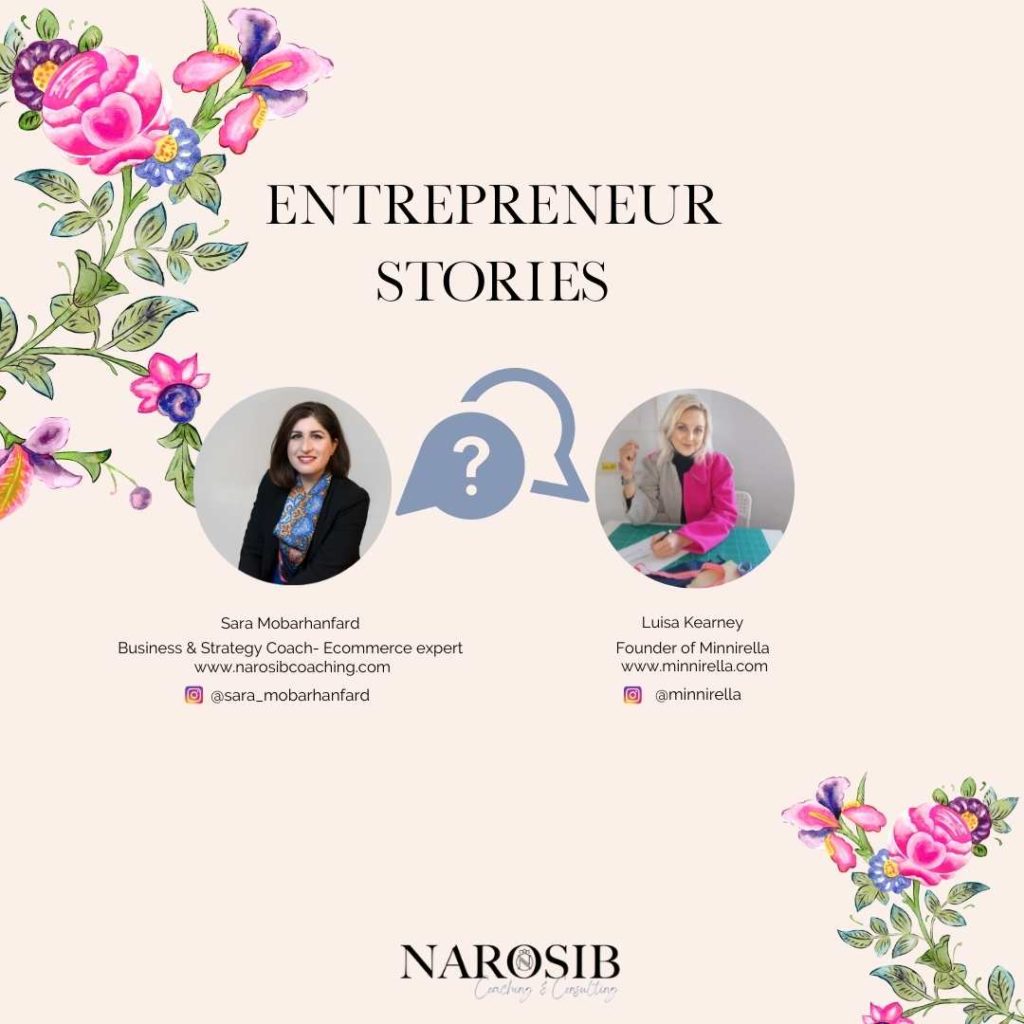
And I didn’t just cover fashion, I covered lifestyle topics and just anything I found interesting.
Then I grew a team a couple of years ago. Because it was getting too much with all the writing.
I then grew the blog into a magazine.The magazine used to be a monthly issue. The issues are now out on a quarterly basis instead of monthly, like four times a year, because we wanted to keep the quality high.
We were also getting other fashion brands in the magazine.
Sara Mobarhanfard:
That’s so interesting. Actually, before we started our talk, I was stalking your magazine! I saw the last version where you had an interview with one of the members of the Cartier family. Juicy!
Luisa Kearney:
Yeah! We’ve worked with so many amazing people. It just has been incredible.
We were taking it down to a quarterly magazine called quarterly issues. It allows us to focus on quality content, things that we really want to put into the magazine. And we also have a fashion brand as well!
But the Cartier interview is really good. It’s a fascinating story. And it was a pleasure to interview Francesca for the who’s actually the author of the book “ The Cartiers: The Untold Story of the Family Behind the Jewellery Empire: The Untold Story of a Jewellery Dynasty”
Sara Mobarhanfard:
You seem to be also very passionate about your magazine. To me, it almost looks like running two businesses which are very much connected to each other.
How do you manage running both the magazine and the product side of your business?
Running a magazine next to a zero-waste fashion brand
Luisa Kearney:
I remember when we launched the fashion brand last September. I was juggling, launching the fashion brand and then also getting our September issue out!
We had so many brand collaborations for our September issue. It really needed to be perfect.
It was really at the end of September (after finishing the issue), I decided that we’ve got to take the magazine down to quarterly because it was just getting too much.
Now time management really is key. I allow myself a certain amount of time to plan the magazine content.
I have my team that mainly covers the magazine. They take care of the content creation, outreach, brand, collaborations, things like that.
The fashion brand side of things is actually quite small because I design the garments and I plan for the fashion brand.
I outsourced the manufacturers to our individual seamstresses and tailors.That side of business is quite small so I run most of that myself.
But the magazine side of business is where my team comes into play, because they take care of the content writing and so on.
When we plan an issue, I sit down with a team, they pitch their ideas, or they tell me who they think would be a really good fit for the issue,I approve their story ideas and interview opportunities.
If they have the opportunity to interview somebody, or a brand collaboration, then they get to work on the content writing and gathering all the content we need, then we put it together.
And that’s how we form the magazine!
zero-waste fashion & zero waste (of time!)
It’s mainly about time :I’m very careful with my time. But yeah, it is a little bit like running two separate businesses. But at the same time, I find that promoting the magazine has a positive effect on the fashion brand: People discover the magazine, and then they discover our fashion brand and they enjoy both!
It goes hand in hand quite well.
Sara Mobarhanfard:
Seems like a brilliant strategy! With my clients ,when we’re talking about content, or how to do Instagram or social media I always tell them creating content is like creating a magazine for your business.
You are really doing it in the proper way!
I can imagine how it connects with people.
It’s so exciting for the audience to read the magazine with all those stories. It builds an authentic connection with the brand.
Luisa Kearney:
Yeah, thank you!
And it’s interesting, because my first business was actually an online travel and lifestyle magazine. But when I set up Minnirella in 2014, it was just a blog.
I was thinking, yeah, it doesn’t really have to be a magazine this time. It could just be a blog, I suppose it’s kind of the same thing, content creation!
Now I’ve got a team and writers to help me. It’s different for me, I’m now able to do the magazine, have a blog and a fashion brand. It’s quite lucky in that way!
It has taken time to grow it to the point where I can do this. I do feel that the magazine is a great asset to our brand. Because it does help. People can look forward to it whether it’s a monthly or a quarterly magazine, I think we still all enjoy looking at magazines, whether they’re digital, or print magazines.
It gives our readers and our customers that feeling of something special, like a free gift or if they want to read it online or we give them the option if they want to download it for a small price.
It gives them that feeling that they can have a little piece of the brand or somewhat exclusive content.
Sara Mobarhanfard:
Brilliant! Where does the name Minnirella come from?
How to find a name for your brand without overthinking
Luisa Kearney:
It’s my dog’s name!
It’s a funny story. Well, originally when I set up Minnirella in 2014 ,we were called my personal stylist and I was the creator of the #onlinepersonalstylist hashtag on Instagram.
Back then in 2014 I started as a fashion stylist and blogger offering online personal styling services. The online styling was still quite a new thing.
A lot of people are doing it now and also shops, online shops are now offering free online personal styling advice.
But then in 2014, it wasn’t that big. I managed to find the domain name easily as
mypersonalstyling.com and nobody was using the hashtag!
The name was free on Instagram.
That’s how it started but then it was in September actually that I rebranded from online personal stylist to Minnirella. At that point, it just didn’t really make sense because I wasn’t really the online personal stylist anymore.
Now that I had a team it’s not really just me! Online personal stylist sounded like it was just one person and it wasn’t really that way anymore.
I wasn’t offering online personal stylist services anymore, I think people were getting the wrong idea of what I was about.
Naming a business is an interesting topic. Some people say it’s just a name. And that is why I only changed the name in September.
Sometimes you have to go with what you know if it’s like if it’s an if it’s a name that makes you happy. I think sometimes you can really put your personality and soul into something.
I thought I knew I love my dog Minnirella. My dog is always my best office companion and always sits beside me!
So yeah, why not call my business Minnirella then?
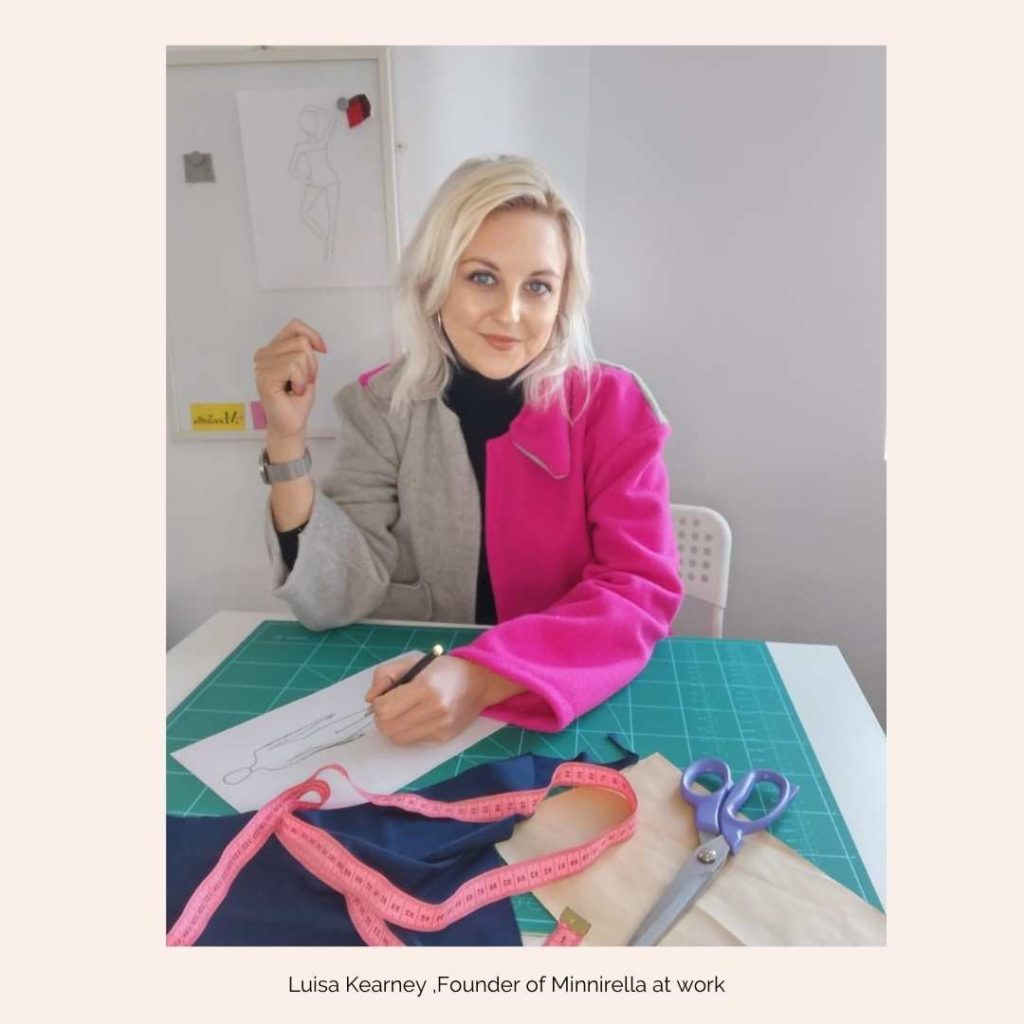
Sara Mobarhanfard:
I sometimes see people spend so much time on”what to name my business”, and I get asked alot about it. And this is not really like a key topic for them.
It has to be something that you feel connected to, you feel comfortable with and then get on with the business.
It is actually quite simple!
Luisa Kearney:
It is quite difficult thinking of a business name in a very short amount of time.
Months before I actually named the blog, I initially created it in my personal diary.
First, I used my initials LMKstyle.com.
I later found out that I obviously missed this somewhere when I was doing my research that LMK style is actually some kind of hunting knife brand!
Or my website was initially called “online personal stylist”. But there was another website, run by an established blogger back then called Online stylist. People were coming to me saying: ”Oh, you’re the other online stylist”.
I think in branding, obviously the goal is to be unique. I never felt really comfortable with being like the other online stylist, although we were doing quite different things.
I thought Minnirella was quite unique.
Naming a business can be a difficult topic because you can overthink it!
As well as finding unique domain names with your available name can sometimes be really difficult
Sara Mobarhanfard:
Yeah, exactly!
Your Brand has a very strong sustainability message.You talk about zero waste fashion.
What does it mean exactly?
What makes a brand zero waste?
Why create a zero-waste fashion brand?
Luisa Kearney:
I call ourselves zero waste. And I think when you’re approaching the topic of sustainability in fashion or any industry, if you’re marketing yourself as a sustainable brand what makes you sustainable?
Are you cruelty free?
Are you vegan?
Are you zero waste?
Are you organic?
Sustainability is quite an open topic.
Sometimes people get disappointed if perhaps a brand is zero waste, but not vegan.
Or if a brand is vegan or cruelty free but not zero waste.
I just wanted to go in with being a zero-waste fashion brand, I don’t claim to be anything more than that.
In our website content we cover a lot about how to upcycle your clothes, repair your clothes.
This also comes out on the blog in our content. With our fashion brand, we don’t waste any of the material that we either buy in or we reclaim in any way.
We use all of the materials we have.
Some of it is deadstock or upcycled materials, or the other times we do buy in material.
They’re all sourced from Italy,using ethical dyes or at least good high quality dyes.
We use every scrap material. We never waste any of the material that we buy in or have.
Sara Mobarhanfard:
I saw some scrunchies on your website. So that’s probably like an example of when a little piece of garment is left and we don’t know what to do with it? There’s still hope for that piece!

Luisa Kearney:
Yeah, exactly. Or you can make it into like, different motifs on T shirts and things like that.
So yeah, there’s so much you can actually do with it. And I think as far as I know, this journey of exploring how to sort of cater to that need.
People want to find brands that are sustainable, and they think about the planet.
I was thinking how to do that in the best way possible. I really liked the idea of being a zero waste brand.
I was looking into ways of making all the different fabrics left or these little fabric scraps. There is so much that you can do with it.
At the end of day, even if you are left with different tiny scrap pieces of fabric, it’s worthwhile to do something practical with them.
Sara Mobarhanfard:
I’ve always loved the world of fashion. It is so exciting. There’s so much creativity in it. But I am also concerned about how much waste this industry is making and the fashion industry is contributing to pollution of the planet.
You’re not doing anything crazy! It’s something that’s accessible to a lot of people but you’re doing your share, to at least contribute less to this whole pollution topic.
Once I did a survey among my audience: I asked them:
Do you care about the source of the clothing you buy?
Do you care if they are made ethically or are you comfortable buying from Zara, Mango, this sort of fast fashion brands?
The answers were interesting:
Half of them said they actually care: They want to make sure they buy from certain ethical brands. They care about where the clothes come from.
The other half said they would like to, but they don’t know where to start! Zara has some very nice stuff for a low price. At the price of weekly grocery shopping you can get a really nice coat!
What advice do you have for people who want to incorporate more sustainable or environmentally friendly habits into their fashion choices?
How to be a more conscious fashion consumer (even if we can’t do zero-waste!)
Luisa Kearney:
That’s a really good question actually. Because it goes back to our ethos really!
Going back to the early days of Minnirella when it was just me creating the blog, then known as the “online personal stylist”,I really wanted to be a sustainable fashion stylist or a sustainable fashion blogger.
I noticed that it was very difficult to change people’s opinions.
For example, if they shopped at Zara, they liked Zara’s style!
Even if one’s really into sustainable fashion, you can go into shops like Zara, and you can’t say that you don’t like the clothes, they look nice!
And they’re a good price!
In order to change people’s opinions, you need to be able to steer people in the right direction so that they can find their style and the sort of things they like to buy, in a sustainable way.
It could be buying second hand or pre-loved clothing. Again, it’s something affordable, you can get some really gorgeous pieces. And it doesn’t have to be a completely different style, you can still get the same sort of fashion trends and things you’d find in somewhere like Zara, but at an affordable price as you’re not buying new all the time.
So that’s one way!
And also, I think just doing any kind of improvement is better than nothing. It’s not about throwing away all the clothes you already have!
This obviously is not going to help the planet. It’s not a sustainable practice to throw away everything for no reason, no matter whether it’s sustainable clothing or fast fashion.
Wear what you have, if possible, try to wear everything you have at least 30 times! There was a couple of years ago, a 30 wears challenge with a dedicated hashtag #30wears.You would post a picture whilst wearing something you’ve worn at least 30 times.
Wearing what you already have is the best way to be sustainable.
Swapping clothes would also be a good way.
Or even just invest in one high quality item from a sustainable brand.
You can upcycle clothes that you already have.
We have a lot of tips like this on our blog, like how to upcycle your clothes, how to repair the clothes you already have, how to make them more interesting, how to create different styles, how to make different outfits using the clothes in your wardrobe.
And then obviously with the fashion brand, it’s zero waste.
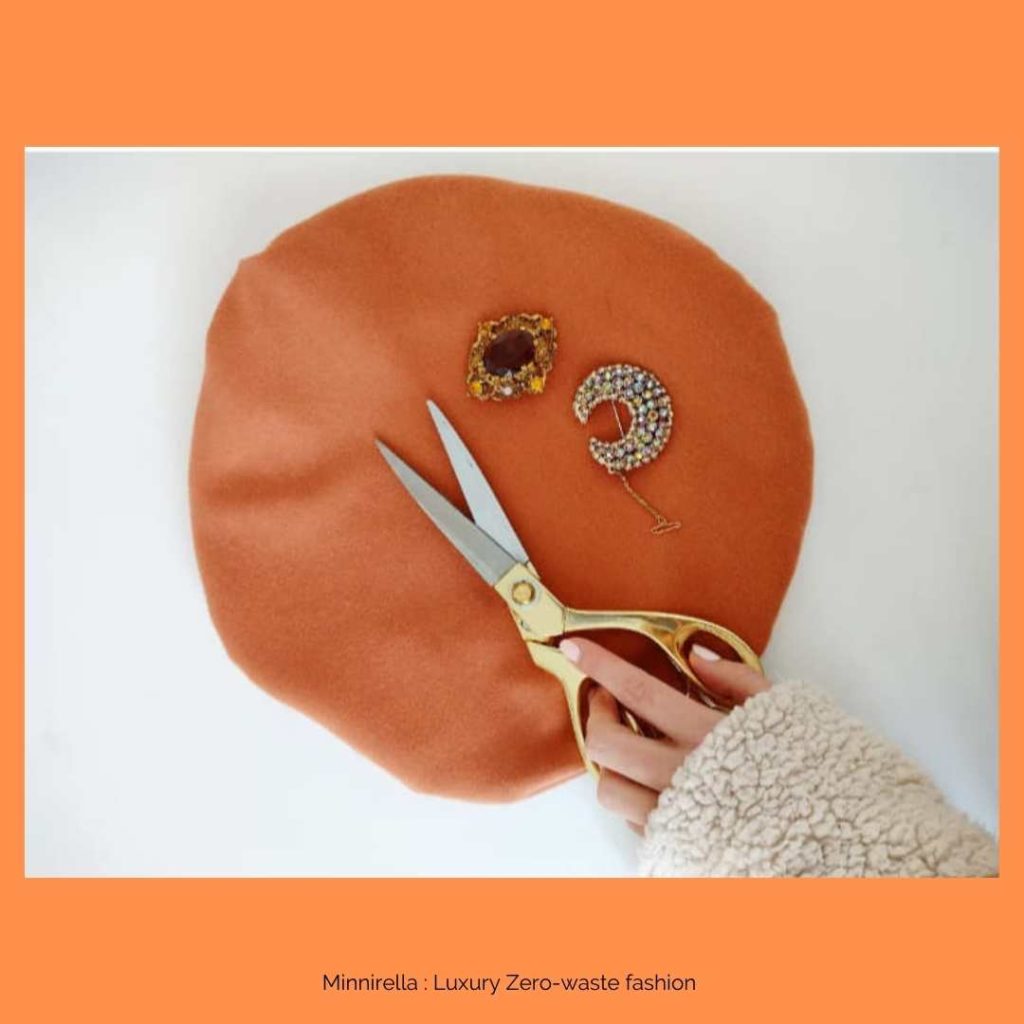
We’re as ethical as we possibly can be, we don’t waste anything! This applies as well to people who work for us.
When it comes to the people who work for us, we manufacture in Europe, and all our seamstresses, and tailors and everybody who works for us on the fashion brand side of things are all paid a proper fair wage and they work at their own pace.
We support small businesses and individual seamstresses and tailors where possible.
Sometimes we might manufacture on a larger scale, but usually we use individual businesses. Therefore, we are kind of like a fair and zero waste brand.
I think for me, it was important just to encourage people to do something that’s manageable for them, if they want to make a change.
Don’t throw away everything you already have and start new, just perhaps start to incorporate new practices into your life.
And then use the clothes you already have. When they start to wear out, you can maybe do something useful with material: perhaps use it or make it into something else, like shred it and fill a cushion with it, that’d be a great idea.
And then, you can start to incorporate more sustainably made pieces into your wardrobe.
I don’t want to frighten people off from being sustainable.
I think our brand is like the middleman between those who are doing a really great job at being sustainable, they’ve been doing it for years, read a lot about the topic and about being green, and those who want to make a difference but don’t know where to start.
Maybe they like the stuff in Zara, maybe they admit it, maybe they don’t want to admit it. Because sometimes, you can feel as though you’re being judged by reaching out.
I just wanted to offer a place where you’ll find advice in a non- threatening way. If you want to prolong the life of your clothes in your wardrobe, if you want to buy something new, we also have zero-waste clothing as well!
“Sustainable fashion brand” is not a clearly defined term
Sara Mobarhanfard:
I love how practical your advice is. For a normal consumer. A lot of people think the only way to do it is just have everything bought from brands who call themselves “sustainable”. And that’s it.
Then you can claim yourself as a sustainable shopper!
So, it becomes intimidating. It’s not exciting to some people. I really liked when you explained about how to just repair everything we have, keep everything in good shape!
Pretty much just like how our grandparents did in the past.Back then they bought quality stuff. They took care of everything. And they had a few pieces that were quality.
A lot of what you described reminds me of what my grandmother used to do in the past I also love how you also support other small businesses,I think, talking about sustainability, small businesses are generally more environmentally friendly than the big businesses because we just do what makes sense: less transport, less wastage
because we are working with smaller budgets.
Bigger corporations, they have such big budgets, it’s okay for them to waste a lot of money or burn a lot of extra stock, so really just buying from independent brands.
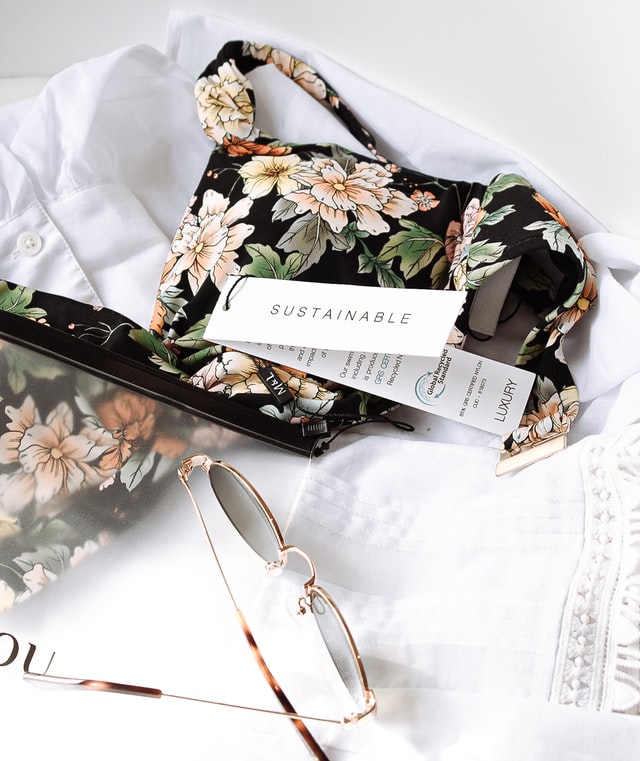
Supporting a small business is like creating a happiness chain
Luisa Kearney:
Yeah, I agree. I think it’s, there are so many big brands doing amazing things. But I think it’s nice as well to be able to support small businesses, especially over the past year or so with the pandemic and everything.
Like all brand owners, I like the idea of growing on a really rapid scale. But I also like the idea of having control over everything in a good way, meaning that I can choose who I work with, in the way that you can support small businesses.
We can outsource our production to independent seamstresses, and it seems just painless.
So [by supporting a small business] you’re providing them work, they’re very highly skilled at what they do. It’s a passion for them. So this is kind of creating happiness all around, in a way!
They’re very happy, they really enjoy their work, they’ve obviously set up that other business. So a product that was made in a happy environment, sent to a happy customer via a brand that’s trying to make everyone happy all year round!
That’s really what I always wanted to do, I suppose.
Sara Mobarhanfard:
I love the human connection. I had a fashion brand too and, and just the fact that for example, this scarf has been hemed by some lady in north of Italy and I know that lady and it’s just the human touch is so strong when you buy from a small business, it really comes from a human who actually knows what they’re doing. That’s what I like about small businesses!
Of course, we need big corporations. I’m not saying all big businesses are evil, we need them, they are part of the economy. But when it comes to things we have a choice, It’s so beautiful to become part of that happiness chain.
How much should you care about the competition?
Now, I have another question, which I get a lot from the clients I work with :They often have concerns about the competition!
It’s not even clear what the competition is,but it’s an intimidating word to a lot of people.
How does the word competition sound to you? I ask this, because fashion is also a very crowded industry, there are so many brands, how does it affect the way you run your business?
Does it worry you or does it make you excited?
Luisa Kearney:
That’s really interesting. Because when I was running my translation business years ago, I kind niched myself into a very, very niche category. So the language combinations we dealt with were very unique. It sounds kind of strange!
Now it doesn’t really sound like there was much of a strategy there when I say it like this, but literally, whenever we contacted anybody who might have needed translation services, they were quite happy to use us.
And we landed the clients straightaway. So there was no competition. A lot of people around me ,my friends and family, were concerned about me leaving that to become a fashion blogger and fashion stylist.
I think I just wanted to sort of connect with people and also do something that I thought was going to be more interesting to the people around me.
With translation services, an average person like friends and family, weren’t not going to need that service. So it was difficult, they don’t probably necessarily share your work and they don’t want your services, you can’t really talk about it with them.
So I went from a very niche market to a very saturated market. Initially it was difficult. And I think that for me being a writer, having different qualifications, like being a fashion blogger, also being a fashion stylist really helped me differentiate myself.
I think the more specialisations you can add to your business the better because it differentiates you from the crowd. So initially, competition was a problem and I did have that comparisonitis where you compare your chapter one to somebody else’s chapter 20.
I don’t feel like that so much anymore because I genuinely think I just try and focus on the good.
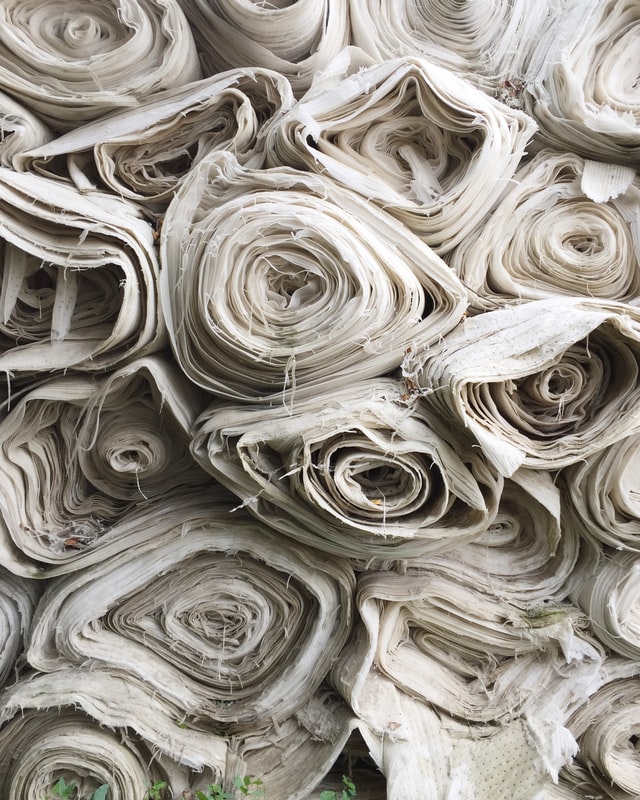
I used to get really wrapped up in this, I will admit that.I’d probably post something that I thought was great, and then I’d see somebody else and think, Oh, is that I’m never going to be like them, you know, I think we all have these days, but now I don’t, I feel like, I’m happy in what I’m doing. This is exactly what I want to do.
And yeah, they might have more followers, or they might be selling more products, but I’m sure there are things that if I was running that business, that wouldn’t have been a good fit for me.
So I’m happy with the way we work.I don’t really get affected by competition anymore.
And I feel that the closer you get to that stage where you’re really really happy with the products you offer, the way you work, the way you manufacture, your processes, people around you,that feeling of being accomplished and content with what you do, really shows in your work.
And I think that in a way has attracted more customers to us.
Because when you’re clear on what you do and who you are, it’s obviously easier for the customer or reader to understand that as well.
It’s more simple for them to buy from you or to connect with you.
Sara Mobarhanfard:
Thank you. very interesting. I see just by being yourself, your true unique self and sticking to what you really believe in, there’s no competition, there’s no other person like that who can exactly do what you do!
Just by being okay with that we can do so much.
And competition in the sense that is defined in business books for big corporations may not actually apply to you as a small business.
So by just being okay with what you do, and sticking to who you are, you’re doing fine.
I’m saying this because I know a lot of people who would listen to this, they are not starting their business just because they think the market is crowded.
This breaks my heart.
Or they want to introduce a new product but they say that the industry is crowded, and they just don’t believe in themselves that much. They just don’t take the steps. And it’s sad.
Luisa Kearney:
Yeah, it is!
I remember, right back to when I was at school, I really wanted to study fashion design when I left school.Nobody thought it was a very good idea.
Because it was a really saturated market. So there was never any support. I think sometimes there is not enough support from school for those creative topics.
But I think what you have to remember is that if you differentiate yourself where you can be and be yourself, you can always find a niche.

You can combine all your (irrelevant!) passions in one business!
And you can always find a way to incorporate something that you want to do or even a hobby of yours. Something that’s really important to you, for example, if you love languages and you love fashion, you could combine the two!
I actually know people personally who did these jobs : they become translators or interpreters for brands, like L’Oreal and Louis Vuitton and the big brands like that, and it’s such an immediate, nice, neat experience for them.
Whatever you want to do, even if you have a number of interests, why not incorporate them?
You don’t have to make separate businesses. You can be a multi passionate person and incorporate all your skills into one, one business and one service or one offering!
So, yeah, it’s just about being creative. But Be true to yourself. Think about what you love, what interests you. And if you can merge it all into one, that’s great.
It’s so real. It shows a unique side point as well!
How to stay resilient
Sara Mobarhanfard:
When you were going through difficult times, I’m sure you also have had your own share of ups and downs, what kept you going and made you stay in this game?
Luisa Kearney:
I’ve had a lot!
I think I don’t often show it and I think some of the problems have been caused by myself.
I think sometimes I’ve not probably been that clear on what I wanted to do.
Then you know, you have that shiny object syndrome where you think oh, I can do that to my business, and in the end, sometimes, you know, your business can be quite complicated or your message isn’t clear or something like that.
Sometimes life can get hard, obviously, we’ve had Brexit and COVID to consider in recent years, and I’m sure that resonates with a lot of people.
COVID didn’t really affect my business in the way of losing clients or anything like that. But it did affect us when we’ve had to ship anything, or with the magazine side of business, if we’ve had anything sent in to review or anything like that, it slowed things down as to Brexit.
So that was a bit of a nightmare. But I think for me, the one thing that really keeps me going is that casino effect (I’m not a gambling person!)
When you think you’ve got to keep going, because you never know if you give up now, you’re going to be so sorry, because you’ve got this far.
It’s like that saying you’ve got this far only to come this close!
I don’t recommend gambling, just to be clear!
That’s just kind of the way I see it. Like if you’re playing on a slot machine.
And you’re thinking, I’m so close, you know, and it does, get better wherever I feel like giving up.
It always changes and something works out and I overcome the problem.
And it is difficult.
Sometimes the challenges are terrible,really difficult. But you just got to stick in there and think what if I quit now I’m going to be so so sorry, because it’s going to take so long to build this up again.
I’m just going to be so sorry if I quit.
I think dealing with quitting would be harder than dealing with the problem I’m facing!
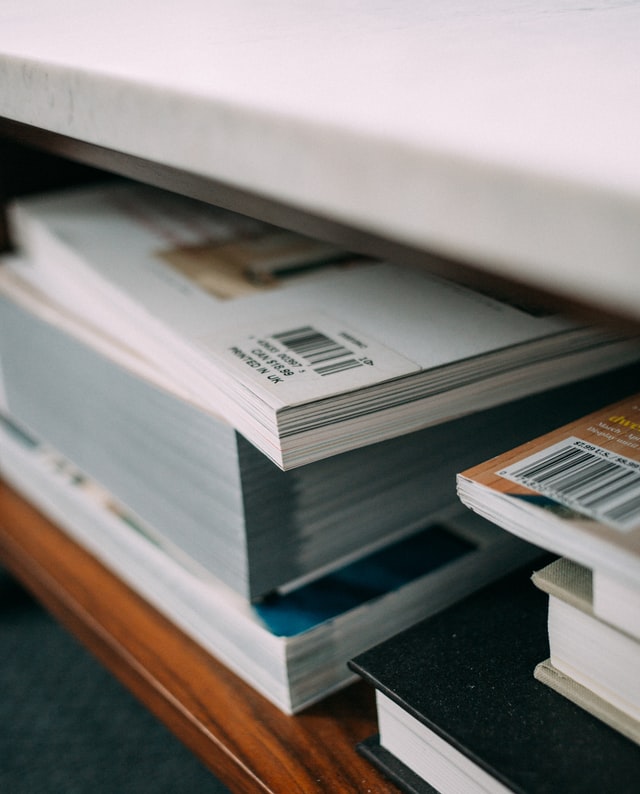
Sara Mobarhanfard:
And what advice would you give to someone who wants to start a new business in the field of fashion or lifestyle right now?
What’s the one thing you would tell emerging women entrepreneurs?
Luisa Kearney:
First of all, just go for it!
And also one of the best pieces of advice that I have received years ago when I first started out in business was a quote by someone (obviously depends on what you fill your day with) :
If you dedicate the same eight hours a day ( that you would normally go to work for) to building your own business, you’re almost guaranteed to succeed.
Obviously, you do have to think about what you’re going to spend that time on.
If you’re doing something that’s not really useful for those eight hours, it’s not going to be beneficial.
But if you as long as you’re dedicated, and you do everything that needs to be done, and you’re consistent, I think you’re guaranteed to succeed.
Sara Mobarhanfard:
Thank you! How can our audience find you?
Luisa Kearney:
Everything , our Instagram , Pinterest and all our social media is called Minnirella!
Website: https://minnirella.com
Instagram account: https://www.instagram.com/minnirella
Facebook: https://www.facebook.com/minnirellaclothing
Pinterest: https://www.pinterest.com/Minnirella
Sara Mobarhanfard:
Luisa! That was amazing. Thank you so much for your time.I learned so much from you. And thank you so much for sharing all your tips and advice and your story with our audience.
Luisa Kearney:
Thank you for having me as well. I really enjoyed it!
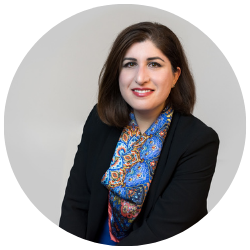
Was this interview inspiring for you?
Do you want to grow a sustainable business on the side ? Are you multi-passionate and don’t know which passion to focus on first for starting a business?
Then book a discovery call with me and I will show you how!

